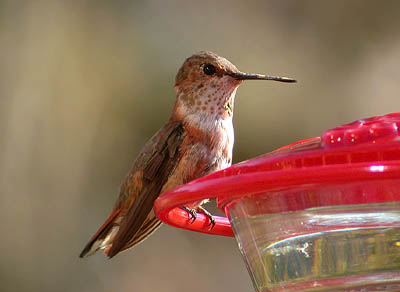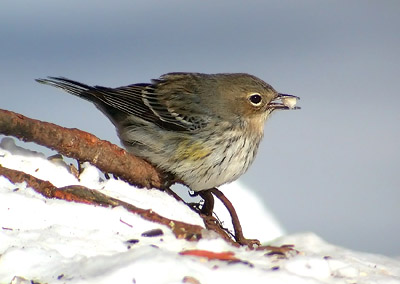Well...perhaps, but not so fast.

What's wrong with being optimistic about its chances? I am. Of course I know the hardships of migration will eliminate millions of birds each spring and fall, but I think many such vagrants, especially hummingbirds, are heartier and more resilient than we've understood in the past and presently give them credit for. Why is it assumed that the vagrant bird we're watching is the one that's going to die?
I'll not deny that vagrancy can be costly. If studies on mortality rates and vagrancy exist, I would be very interested in learning about them. However, I do know there are records of late vagrant hummingbirds banded in the northeast, recaptured only days later further to the south after a major cold front had moved through. Amazingly, in other cases banded birds were recaptured in subsequent years having endured the "vagrant path" more than once.
What are these birds truly capable of? Take the Ruby-throated Hummingbird and its migration potential. It can cross the Gulf of Mexico in a non-stop 24-hour flight. That's around 600 miles! When survival is at stake, how much distance can other hummingbird species put between them and a storm front? Give them a little credit!
Hummingbirds can also thermoregulate their body temperature to drop almost 50 degrees and go into torpor - a type of nocturnal hibernation or noctivation. Their heartbeat can decrease from 500 beats per minute down to 50, lowering its metabolic rate by as much as 95%. Even its breathing may briefly stop.
Some have said torpid hummingbirds exhibit a slumber that is nearly as deep as death. In 1832, Alexander Wilson first described hummingbird torpor in his book, American Ornithology; "No motion of the lungs could be perceived ... the eyes were shut, and, when touched by the finger, [the bird] gave no signs of life or motion."
Nevertheless, they awake. It takes a hummingbird nearly 20 minutes to come out of torpor and a bird in such a lethargic state is very susceptible to being taken by predators. But that's the give and take of such a survival strategy - good for enduring cold snaps, but potentially dangerous in other ways. That it is an adaptation is a powerful indicator that it works far more often than it fails.
Anyway, I observe this gloomy "bird must die" sentiment over and over again. The lingering Cave Swallows that came through the Midwest last winter all died. The Ash-throated Flycatcher that was seen up until a severe cold snap died. Some birders confessed to me that they thought the Yellow-rumped Warbler in my backyard last year would die the night the temperature dipped to 15 below. Well, it didn't. But they killed it off when another birder told me that a Cooper's Hawk must have eaten it after the warbler hadn't been see for a few days.

Just because such a bird is no longer being seen doesn't necessarily mean it died. Of course it doesn't prove it survived either. Where's the corpse? But if vagrancy means certain death, as some birders on listservs invariably portray it, then why does it exist? I mean, can't a bird just fly away every once in a while?
All images © 2006 Michael McDowell

















